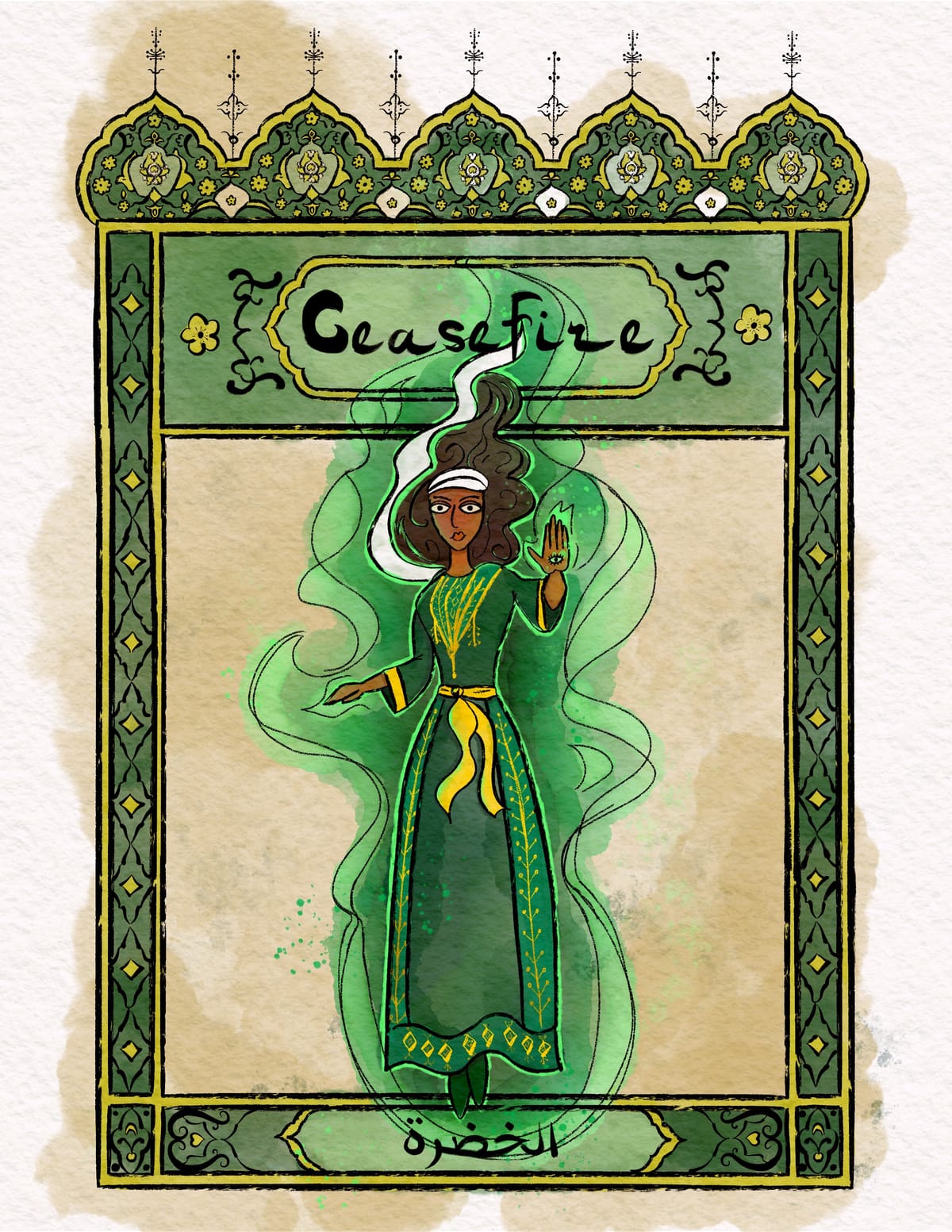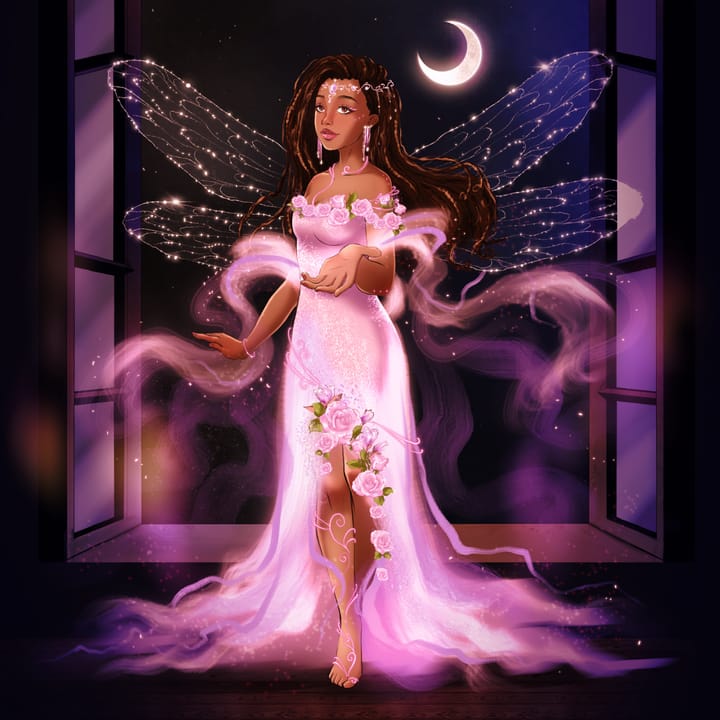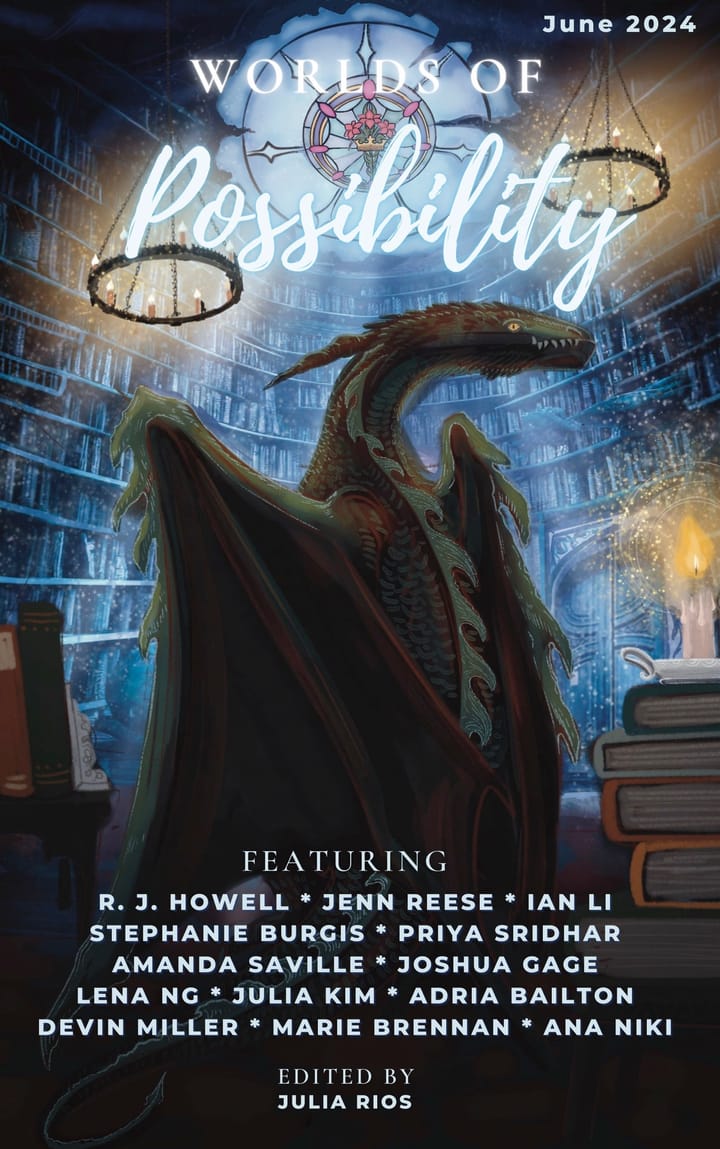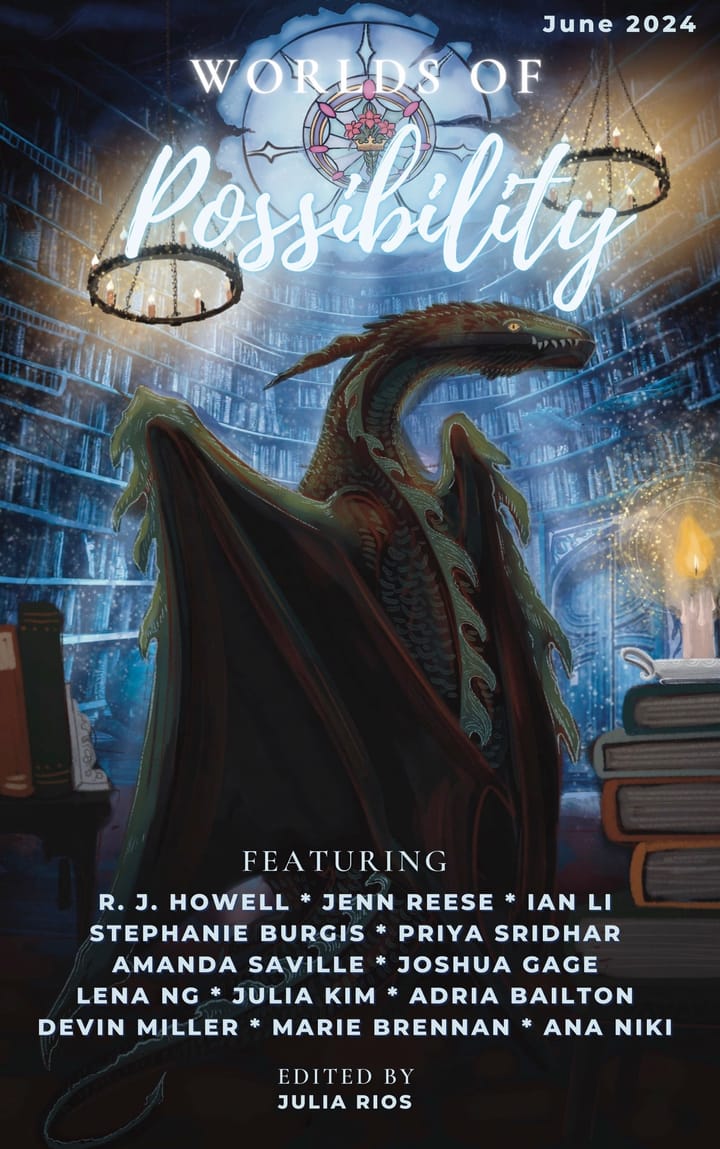Ceasefire Art by Alex Hernandez
This art by Alex Hernandez is part of the December 2023 issue Worlds of Possibility. The ebook of the entire issue is available to download for free as an end of the year gift.

This art by Alex Hernandez is part of the December 2023 issue Worlds of Possibility. The ebook of the entire issue is available to download for free as an end of the year gift here: https://www.juliarios.com/the-december-2023-issue-of-worlds-of-possibility/.
This art was inspired by the life and work of Tawfiq Canaan, a Palestinian doctor who did research on several different diseases, including some that contributed to finding a cure for leprosy. He was also interested in documenting and preserving Palestinian culture. He had a special interest in superstitions, and collected many talismans and other objects related to that. His written works about these include the 1927 book Mohammedan Saints and Sanctuaries in Palestine, which has been scanned and is available on the Internet Archive.
Canaan’s home was destroyed in 1948 as part of the war, but he continued to live in Jerusalem until his death in 1964.
Alex did an interview with me about his artistic process and the specific inspiration for this image. You can listen to that as a podcast (which also includes the December 2023 editor's note and an interview with Beth Wodzinski about her art), or read the transcript below.
Listen to "The December 2023 Issue of Worlds of Possibility Is Here!" on Spreaker.About the Artist
Alex Hernandez is a Cuban-American speculative fiction writer, editor and artist. His work often explores themes of migration, mysticism, colonization and posthumanism. He lives in South Florida with his wife, two daughters, and an overly-affectionate cat.
Interview with Alex Hernandez
Julia Rios: Alex Hernandez has edited work that I have written in the past, but this time he has contributed a piece of artwork to the December issue of Worlds of Possibility. We're here to talk about the creation of that art, his artistic process in general, and then we'll also get a little chance to hear about his other projects. So welcome, Alex! Please tell us a little bit about yourself.
Alex Hernandez: Happy to be here, Julia. My name is Alex Hernandez and I am a writer, artist, librarian by day, editor, and basically anything that involves science fiction or speculative fiction. You know: horror, fantasy... I love all of that stuff, and I like creating stuff like that.
Julia Rios: Yeah, awesome. Okay, so tell us a little bit about your work as an editor, which is how I first got to know you at all. You've worked with the Latinx Rising series. Tell us a little bit about that.
Alex Hernandez: So I first started as a contributor. It's a series, so in the first anthology, I was a writer and I submitted my work and Matt [Goodwin] and I hit it off. We talked about future anthologies. We talked about maybe doing one for YA. We talked about different themed anthologies. And then when he came here to Miami for the launch of Latinx Rising, which was the first book, we were walking around Coral Gables before our thing, and I was really convincing him to do another one and he was just right off the first one. He was tired. He kind of wanted a break, and I was like let's do one. Let's do one for YA. So when he started planning that second anthology, he called me up and was like, "Do you want to help me edit it?"
So that's the start of it, and I enjoyed mentoring young writers, I enjoyed reading writers that I normally wouldn't have read, so I actually love editing because of that. Because I get to develop new voices.
Julia Rios: Awesome! And yeah, I got to contribute a story to the second one, and I know that you're also going to be working on a third one, which you can maybe tell us about at the end of the show. But let's go into the art side of things. How did you get into drawing in the first place?
Alex Hernandez: So I've always drawn. Um I don't know if I'm very good at it. But when I was a kid I always liked comic books and my dream was to be a comic book creator, right? So the writer and also the artist. When I was in my twenties, I realized that drawing comics is really hard and I could probably be better at writing, so in my twenties I kind of let the art go and I just focused on writing and developing that craft.
And it wasn't until I had kids that, you know, me and my kids would do arts and arts and crafts, and I would draw with them and paint with them, and I remembered how much I loved doing art. So now they're grown. You know, one of them is like thirteen, and she doesn't want to do art with me but I kept it up, so I still do art. And I realized that, yes, drawing a comic is hard. It's hard to do a bunch of pages, but I can do you know, one-offs. I can focus on a piece and actually I find creating art to be way more relaxing and I can zone out and just kind of leave my body and do the art, as opposed to writing where I have to be in it and I have to you know, work on it. So I actually use art as ah, like a destressor.
Julia Rios: That's really cool. So tell me a little bit about what inspired this particular piece. It's called Ceasefire. Obviously we're at a point where there's all of the situation with Palestine, and people all over the world are calling for a ceasefire. So that's a clear inspiration. But you specifically also said that this was inspired by the work of Tawfiq Canaan. I'd love to hear more about how you decided to make this piece, what your inspirations were, and also what your process was.
Alex Hernandez: So my inspiration for all art basically comes from mythology or from folk religion, and I love that stuff. Mysticism. I read a lot about that stuff. I look up artwork and illustrated manuscripts and things like that, and I love all of that art, and all of that art really inspires me. I wanted to do a piece to highlight what's happening in Gaza, and I went through my regular process, which is: I immerse myself in that culture. I have learned, or I am learning I guess is the best way to say it, Arabic – specifically the Palestinian Jordanian dialects. So you know learning a language is not in a vacuum, right? With it comes people's culture. People's art. People's history. So I feel really close to that region just because I'm learning their language. So I read up, not just things on language learning, but the folktales of the region.
Tawfiq Canaan was a medical doctor, but he was also an ethnographer and archaeologist and all of these awesome side hustles, and he went around Palestine just collecting stories and collecting artifacts from from the region. And I was reading books that he wrote, or books about him, and you know, every well, every spring, every tree in that area has either a saint you know, living in it, or the ghost of a saint. And that's what a wali [ وَلِيّ ] is. That's what they call them. It literally means a friend of god. Or they have a djinn. Some wells, or some trees, have both a saint and a djinn living in them. So part of the inspiration was just soaking all of that in and looking at art. You know, looking at Islamic art and things like that.
I wanted to kind of remove myself from the modern dialogue because it's so depressing. So I kind of went back to: what are the saints? What are the spirits of the land? What are the djinn, right? What do they think of all of this? And I created a saint.
And the saints could be women or men. There's no official process for it like in, you know, Catholicism. The saints were basically just holy people or people who could perform some kind of miracle. Think of them like cunning folk I guess in European culture. If you've performed a miracle, they would be like, "You're a saint." Right? And it wasn't like only the Islamic people who would honor you, but you know Jews and Christians in that area would as well. So it would flow between cultures, and it was everybody – like the people, right? The people of the land would honor you. So I wanted to do a saint, and she kind of has her hand out. There's an eye in her hand, referencing the hamsa, or the hand of Fatima, and she's calling for a ceasefire.
One of the trademarks of a saint is there's a lot of green light, or a green glow, or a green fire associated with them. Usually their heads are glowing green, or their faces. So she's like surrounded in green fire because, as I said, I was a comic book nerd. There's a lot of Green Lantern influence there as well. But that's the influence for the piece. And her name is Al-Khadra [الخضرة], and that means the green, like the green lady. And there were actually several saints that were called Al-Khadra that were either female saints or male saints and they were called either the green one or the green lady.
Julia Rios: But she's one that you've made yourself, so she's not like a specific one. She's one that you've dreamed up?
Alex Hernandez: Yeah, it's a composite. So there's not a lot of information on these that have survived, so she is one that I dreamed up, but she is more like a composite of two female saints. They were both called the Al-khadra, like the green ladies. They were just from different towns, but you know that's kind of what she is, kind of like a merge of the two saints. Yeah.
Julia Rios: Okay, so what do you know about the two different saints that you say she was sort of based on?
Alex Hernandez: Well one of them... again, this is basically what Tawfiq Canaan has collected – and one of them there isn't a lot, or I haven't been able to find a lot about, but the other one... She's from his hometown. She was a young maiden and this rich, I don't know, sheikh, wanted to marry her, and she begged her father to not allow it. And, you know, he said no, but then the guy bribed the entire town and then the entire town (because they were being paid off by this guy) convinced the father to let him marry her. And on her wedding night, he comes into her home, and she yells out, you know the name of the prophets and the name of her grandfather and the name of Allah, whatever, and then he drops dead immediately. So because of that, people were like, "Oh my god it's a miracle!"
And after that they venerated her as a saint.
And I liked a lot about it. I liked that she took matters into her own hands and from the beginning she was saying she didn't want this. She didn't want to marry this guy. The town was against her and she found the way to win, and something about that story I loved. So that's why, of all the walis, of all the saints, that she's the one that stuck out to me.
Julia Rios: Very cool. So tell me a little bit about your actual physical process creating this.
Alex Hernandez: So it first starts with research. I mean, I'm a librarian at heart, so I approach everything through research. I read up on a lot of things. I look at a lot of images. So, for example, the border is more or less my poor attempt to do like an illustrative manuscript type of border. And I looked at, you know, the dresses of the of the area, of the era, dresses of the time. So the dress she's wearing is again my poor attempt at that.
So it's just looking at images and reading a lot, and then I sketch it out. I hate drawing on a tablet. I like painting on a tablet, but I hate drawing on a tablet. I like the physical scratching of pencil on paper. So I sketch it out first on a notebook and then I scan it, and then, in Procreate, I paint it. I add layers to it, and because all of the stories said there was this green glow associated with saints, I played with different greens. So there's a lot of greens in that. Even the yellow is kind of like a lime green type of yellow.
So that's basically the process. It's a lot of looking at art of the region, and not just with this piece but with all the pieces. So if I do something that's inspired by Cuban art or inspired by Mexican art, I'll do a deep dive and I'll look at old images. I find that fun. I find it very relaxing. You know I love learning.
I also make sure that the language is right. You know, if it's Spanish, I'm a fluent Spanish speaker, so that's not always a problem. Maybe I have to double check to make sure I got the accents in the right spot. But when it's something like Arabic that I'm a newcomer to the language, I do want to make sure that it's right, and I do want to make sure that it's the correct dialect for the region and things like that. So it's a lot of process that probably involves not a lot of art work at first, but it's all part of it. It all feeds into the piece and you know, at the end of the day I want to make it as authentic as possible.
Julia Rios: So you say you don't like to draw on a tablet so you do your drawings free hand on paper?
Alex Hernandez: Yes, I always do that. I have drawn on a tablet and I don't like it. I feel the Stylus and the and the screen is too smooth. I like the friction of lead on on paper. But I Also like that I can draw things around it that I may incorporate and with the tablet, it's more... It's more the painting. Like I'll trace it, I'll outline it or ink it on the tablet, and I'll paint it on the tablet, but I always sketch on paper. I've got notebooks, a bunch of notebooks at home with you know, sketches and half sketches and notes and things like that. But definitely painting, I love painting on a tablet more, especially as I like to do kind of like a watercolor messy kind of art. When I try to do that on on actual canvas or on paper with real paints, there's no undo, right? You can't go back. You can't fix it. It's hard to erase. Whereas with pencil, you can always erase.
Julia Rios: Ah, yeah.
Alex Hernandez: So I feel with the tablet it's much more freeing because I can do a whole piece, and if I hate it, I can just delete it and keep the outline and then do it again. With paint, I'm committed to it, right? And I can try to fix mistakes and I can try to you know, work with it. But if it's not working, it's not working. So yeah, that's my secret. Procreate does a lot of heavy lifting.
Julia Rios: So when you have a drawing that you've actually drawn out by hand, how do you actually transfer that to the digital image?
Alex Hernandez: So, a couple ways. Sometimes I'll just use a scan app, and I don't really care about the quality too much because I know that I will go over it.
Julia Rios: So you're just using that as like a template to guide you in the tracing.
Alex Hernandez: Exactly. Or if the image is very involved and I don't want to lose quality because I just I want to use the actual pencils without tracing it in, I might do a really nice scan, like a high quality scan, and then remove the background and fill it in that way. But sometimes what I've done, too, is when I've used actual paint and paper and canvas, I'll do the whole thing in paint and then scan it. Like scan the actual piece and then go in with the tablet and touch it up and do highlights and things like that. So sometimes it's like a collage of, actual sketches, actual paint, and then digital paint on top of it.
Julia Rios: That's so cool. I love hearing about all the different ways the art comes into being. Okay, well thank you so much for telling us all about the inspiration for this piece and the way that you created it. I'm sure everyone listening will be as fascinated as I was. Let us know where we can find you and your work. If people are curious and want to learn more about you, where should they go?
Alex Hernandez: So if you just go to @alexthoth on any social media platform, you'll be able to find me. You'll be able to find my work, whether it be my writing or my artwork. We do have, as you mentioned, the Not Your Papi's Utopia, right? The third installment in the Latinx Rising anthology, and we're in the middle of working the stories. We're in the middle of I guess finalizing the acceptance letters and things like that. So maybe in a year it'll come out. It's a great anthology that focuses on utopia, especially now with how everything is and how depressing the news is, we want to be able to imagine what a better future looks like. And that doesn't mean that all of the stories are rosy, but they definitely create a roadmap for how to get to a better future. So, you know, be on the lookout for that. That should be out by next year.
Julia Rios: I'm a really excited for this one. Like I said, I contributed a story to the YA version, which was Speculative Fiction for Dreamers, and I love that volume. I also love the first volume. I'm really excited for the third one. I can't wait to see what all of the different writers have brought with their ideas of utopia.
Alex Hernandez: It's amazing. And even when they lean toward dystopia, there's always a ray of hope. There's always a pocket utopia within that, and I love that. I love how layered that is, where you can create a little utopia for you and your community, within a larger dystopia. It's very cool. So I look forward to to putting it out there.
Julia Rios: That's great, and that's definitely... with Worlds of Possibility, which is the project that you contributed this artwork for, my goal with that is always to sort of give things that give us a little bit of hope even when we're dealing with difficult topics. So in this issue we have your artwork and we also have an essay by a Jewish activist who is in solidarity with Palestine, and both of those pieces are dealing with a topic and an issue that we're seeing in the news and that everyone is feeling deeply all over the world is very difficult. But what I'm looking for are those little glimmers of hope. Like, what are the things that we can do to make things better? And one of the things is putting great art out there. And then also seeing that people can come together in solidarity, even if they are theoretically supposedly designated as the other side. Like actually we're all in this together as humans and we need to stand up for each other.
Alex Hernandez: Thank you for that, and thank you for the work that you do. It's so easy to get bogged down and get paralyzed by just the doom and gloom of all of it. Art is a way to not just escape but it – I keep saying this – it's not just an escape. It's almost an emergency exit. And we kind of need to hang on to that now.
Julia Rios: Ah, yeah, I agree. Well thank you for creating something beautiful and letting me share it with others, and thank you so much for talking to us. I hope that lots people go and find you online and see more of your work.
Alex Hernandez: Thank you, Julia.


